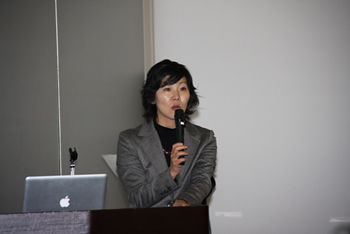
|
Professor Ekou Yagi from Osaka University’s
Center for the Study of Communication-Design
|
The presentation contained the following salient points.
Communications is said to be vital in reducing human error. Sustaining favorable communications is key to reducing human errors that lead to accidents and other problems. And here communications does not mean just communications between supervisors and their staff or between coworkers; it also means communications within groups and organizations and communications with other organizations and with the general public.
To achieve smooth, fluid communications, one must keep in mind that dealing with other people is like dealing with different cultures; one must assume that your communication partners have diverse values and contexts.
Also important is to acquire the art of listening, such as using open-ended questions and pressing for understanding while deferring objections.
Communication is essential to reduce rule violations, which are cited as a leading cause of human errors. “Know why” education explaining the background leading to the rules’ formation is crucial, as is consistent compliance with all rules, including safety rules, and revisions to the rules themselves.
Corporations with good safety records share a number of common points when it comes to communications. These points are useful references for us.
Some key top-down points are communicating management’s dedication to safety, clarifying the scope of responsibilities, engaging in visible safety-first practices, and appointing workplace managers as point people on safety. Some bottom-up points are providing models of ideal activities, adopting simple and efficient safety methods, providing feedback to proposals, taking proactive measures tailored to the workplace’s unique circumstances, demonstrating the necessity and benefits of safe practices, and trying any and all possible activities to instill workplace safety.
Another important action to reduce human error is to regularly measure safety.
For example, conducting a multifaceted survey on safety can be utilized to regularly evaluate safety levels in a corporation as well as to raise awareness and interest in organizational safety.
Finally, it is important to consider changing the criteria of accidents and problems.
As one desire is satisfied, people’s desires only expand and diversify. Similarly, views on technology and safety change over the years.
What I mean is that when society determines what is safe, the decision is much more powerful in many ways than defining safety numerically with technology. I believe this trend will continue to strengthen in the future.
Consequently, communications with the general public and communications between ordinary people and science and technology can eventually lead to the prevention of accidents and other problems.
Comments from the questionnaires conducted after the presentation:
• This was an excellent opportunity for us to review our everyday activities. It will be useful in enhancing our activities.
• The presentation made me realize again how we should deal with safety. By taking a third-party perspective, I was able to confirm whether measures to prevent reoccurrences are currently in place.
• The event was an opportunity to consider human error for a full day.
• The lecture reconfirmed the importance of communications, since many non-conformities and accidents are preventable with the right approach to communications. I was impressed by the speaker’s expression that communication is an act of listening.
• I was able to understand the basic approaches to communications. |







